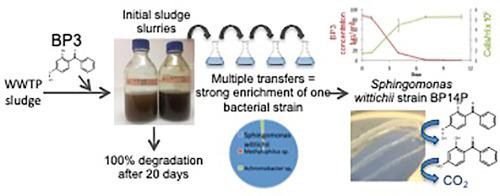Science of the Total Environment ( IF 9.8 ) Pub Date : 2020-11-21 , DOI: 10.1016/j.scitotenv.2020.143674 S.K. Fagervold , C. Rohée , A.M.S. Rodrigues , D. Stien , P. Lebaron

|
Benzophenone-3 (BP3) is a widely used organic UV filter present in many environmental compartments. One way BP3 is released into the environment is through effluents from wastewater treatment plants (WWTPs). These plants are possible sources for degradation activity and WWTP sludge may potentially degrade BP3. Our goal was to identify any BP3 degrading microorganism(s) in WWTP sludge and to investigate whether the degradation was co-metabolic. Initial WWTP sludge microcosms spiked with BP3 showed 100% degradation after 20 days. Multiple transfers of these microcosms, while maintaining a strong selective pressure for BP3 degradation capabilities, resulted in the dominance of one bacterial strain. This strain was identified as Sphingomonas wittichii BP14P and was subsequently isolated. It was shown to degrade BP3 in a growth dependent manner. Strain BP14P utilized BP3 as the sole energy and carbon source and completely degraded BP3 after 7 days in minimal media. We tested the capability of BP14P to degrade nine other UV filters, but the degradation ability seemed to be restricted to BP3. However, whether this specificity is due to the lack of degradation genes, cellular transport or low bioavailability of the other UV filters remained unclear. The efficient degradation of BP3 by a group of bacteria well known for their potential for xenobiotic degradation is an important step forward for a complete risk assessment of the long-term environmental impact of BP3.
中文翻译:

从污水处理厂污泥中分离的维氏鞘氨醇单胞菌菌株BP14P有效降解有机紫外线滤光剂二苯甲酮3
苯甲酮3(BP3)是存在于许多环境隔室中的一种广泛使用的有机紫外线过滤剂。BP3释放到环境中的一种方法是通过废水处理厂(WWTP)的废水。这些工厂可能是降解活动的来源,并且WWTP污泥可能会降解BP3。我们的目标是确定污水处理厂污泥中任何可降解BP3的微生物,并研究降解是否是协同代谢的。最初的WWTP污泥微观世界掺入BP3在20天后显示100%降解。这些微观世界的多次转移,同时保持了BP3降解能力的强大选择性压力,导致了一种细菌菌株的优势。该菌株被鉴定为维氏鞘氨醇单胞菌BP14P,随后分离。已显示其以生长依赖性方式降解BP3。BP14P菌株利用BP3作为唯一的能源和碳源,并且在最少的培养基中培养7天后,BP3完全降解。我们测试了BP14P降解其他九种紫外线滤光片的能力,但降解能力似乎仅限于BP3。然而,这种特异性是否是由于缺乏降解基因,其他紫外线过滤剂的细胞转运或低生物利用度尚不清楚。BP3被异种生物降解潜力众所周知的一组细菌对BP3的有效降解是对BP3的长期环境影响进行完整风险评估的重要一步。



























 京公网安备 11010802027423号
京公网安备 11010802027423号